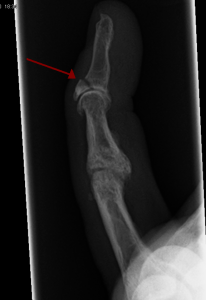HHS v. DKA: 1) What’s the difference? HHS patients, as opposed to DKA patients, usually have some residual circulating insulin that prevents secretion of glucagon and glucocorticoids. These hormones are responsible for the breakdown of free fatty acids and the formation of ketone bodies seen in DKA. 2) What about this patients …
June 2014 archive
Jun 13
CHF and Atrial Fibrillation
A lesson I learned caring for a recent patient: CHF exacerbation in Afib with RVR Clinical Question: What is the best way to rate control in decompensated heart failure? Our first instinct when we see patients with A-fib with RVR is to reach for diltiazem or our beta blocker of choice, however, these are not …
Jun 11
Mallet Finger
Mallet Finger Mechanism: Forceful flexion of distal phalanx results in disruption of extensor apparatus. Patients often present with a flexor deformity. Pathophysiology: This is classified as a type of zone 1 injury involving the DIP joint. 4 Types: Type 1: closed without fracture Type 2: Open tendon laceration without fracture Type 3: Open tendon injury …
Jun 09
Know your RSI!
[notice textalign=”center”]AIRWAY[/notice] As some of the more junior residents realize this time of year… fumbling your way through an intubation looks bad all around. Help yourself by really becoming comfortable with induction and paralytic agents. A difficult airway is, after all, owned by the ED. I wouldn’t want anyone else, even Anesthesia, intubating when there …
Jun 07
Can I use the age adjusted D-dimer in clinical practice? If so, how?
The ADJUST PE trial is hot off the JAMA presses in March 2014. The takehome: of 1141 patients excluded from scanning by clinical assessment plus age adjusted d-dimer, there were only 2 cases of non-fatal PE (0.2%). Of these 1141 patients, 331 had an age adjusted d-dimer greater than the standard cutoff of 500mg/mL. Of these …
Jun 07
CHF or PE? PE is a known and common complication of CHF
challenging case: an obese 60yo patient never seen by a doctor as an adult presents marked peripheral edema, hypertension, and 2 months of worsening DOE, PND, orthopnea. BNP 400, EKG Unremarkable, trop 0.1, stating well. It feels like CHF. But the cardiologist wants a CTPE. We oblige – big saddle embolus with RV strain. This …
Jun 06
Anaphylaxis
Anaphylaxis: 5 Clinically Relevant Questions: 1) Whats the difference between anaphylaxis and anaphylactoid? Anaphylaxis: IgE mediated Anaphylactoid: Direct degranulation of mast cells 2) What are the main causes? Main classes: Food, insects, medications. –PCN Cross Reactivity with Cephalosporin? True incidence <0.1% true anaphylactic cross reactivity –Radiocontrast material(RCM): Shellfish and iodine allergies are not relevant! That being …
Jun 06
How to give thrombolytics
[notice]PHARMACOLOGY[/notice] A great question came up in the zones. We see and likely should be comfortable with the dosing of Alteplase for CVA. Grady is a renowned Stroke Center and I would certainly have any of my family members come to the Marcus Stroke and Neuroscience Center if they were having a stroke. The fact …
Jun 05
How not to get sued…and just good patient care!
Without slowing you down… Sean’s TOP 5 Every patient: 1) Vital Signs: Never ignore them, and never discharge an abnormal one (without a good reason!) 2) Nursing Notes: Read them, and explain any contradictions 3) Reexamination: Document a reexamination on every patient in plain language 4) Shared Decision Making: “Mr. Jones and I discussed the …
Jun 05
How do you assess suicidal ideation?
No Blue Zone shift is complete without seeing at least a handful of “Psych Eval” patients in the newly minted Blue Obs. Until the department of Psychiatry starts up an intake process again at Grady we are left with the burden of screening these patients and making a decision as to whether the patient we …

